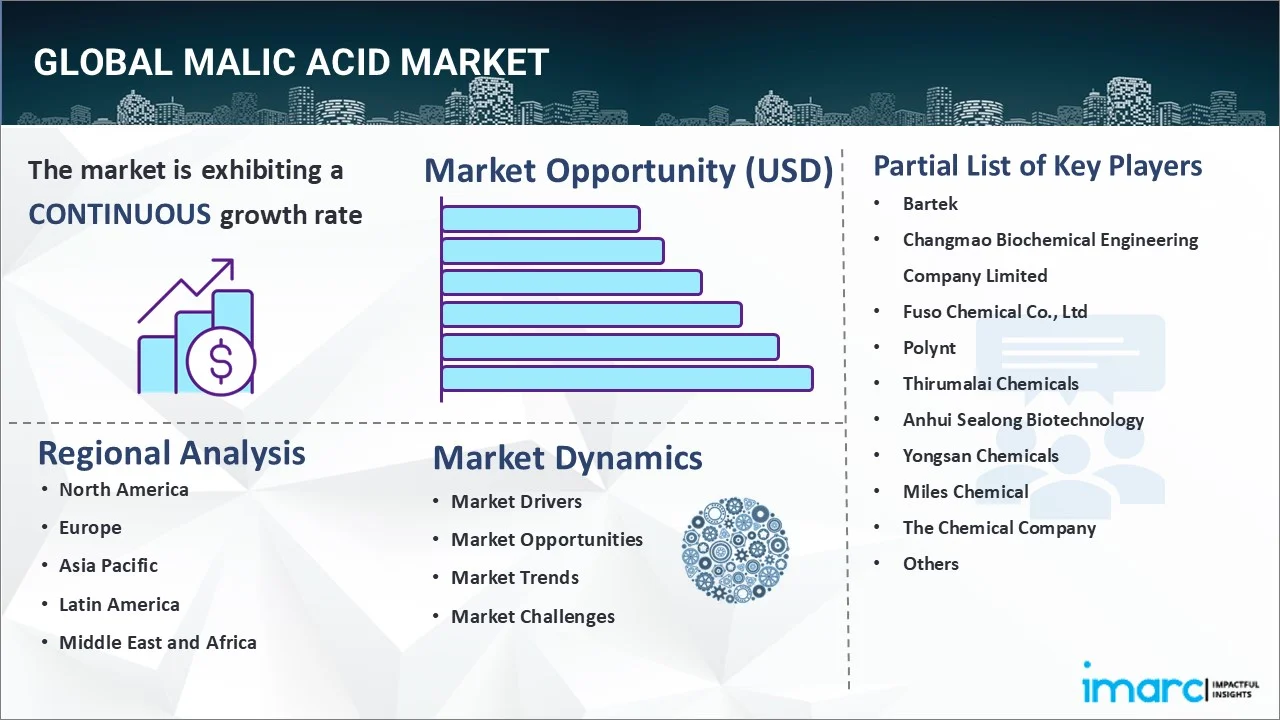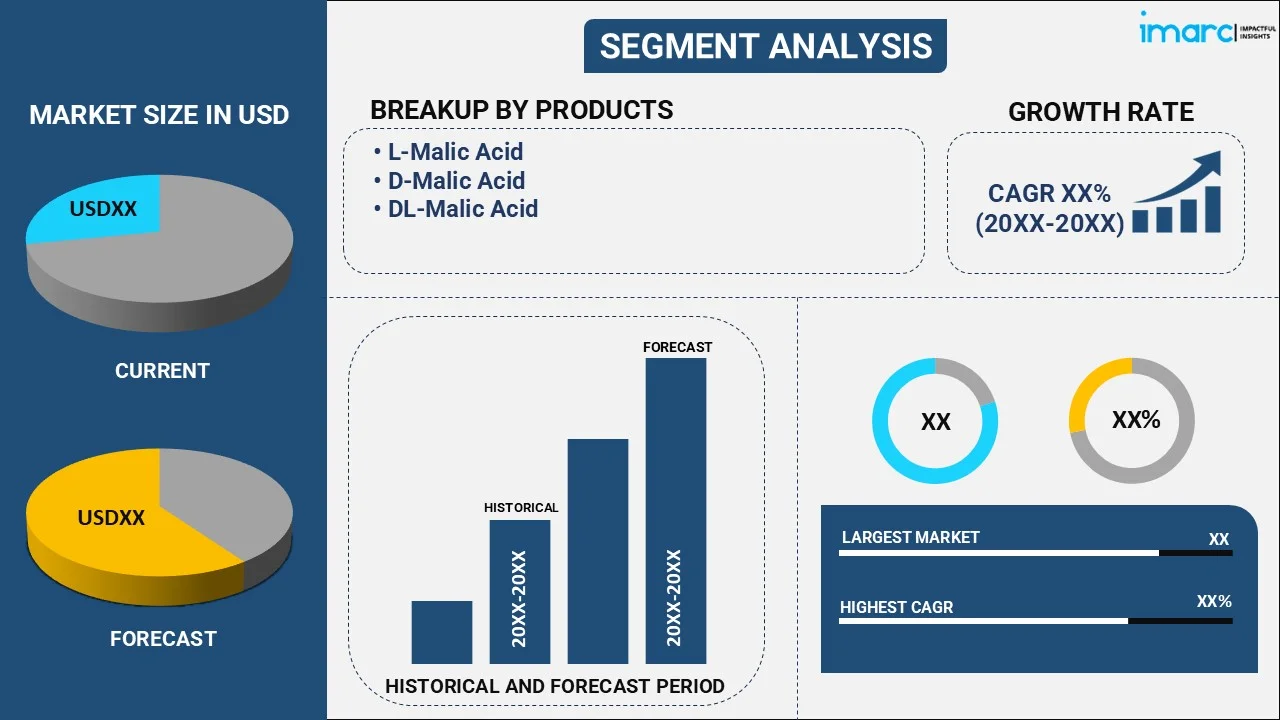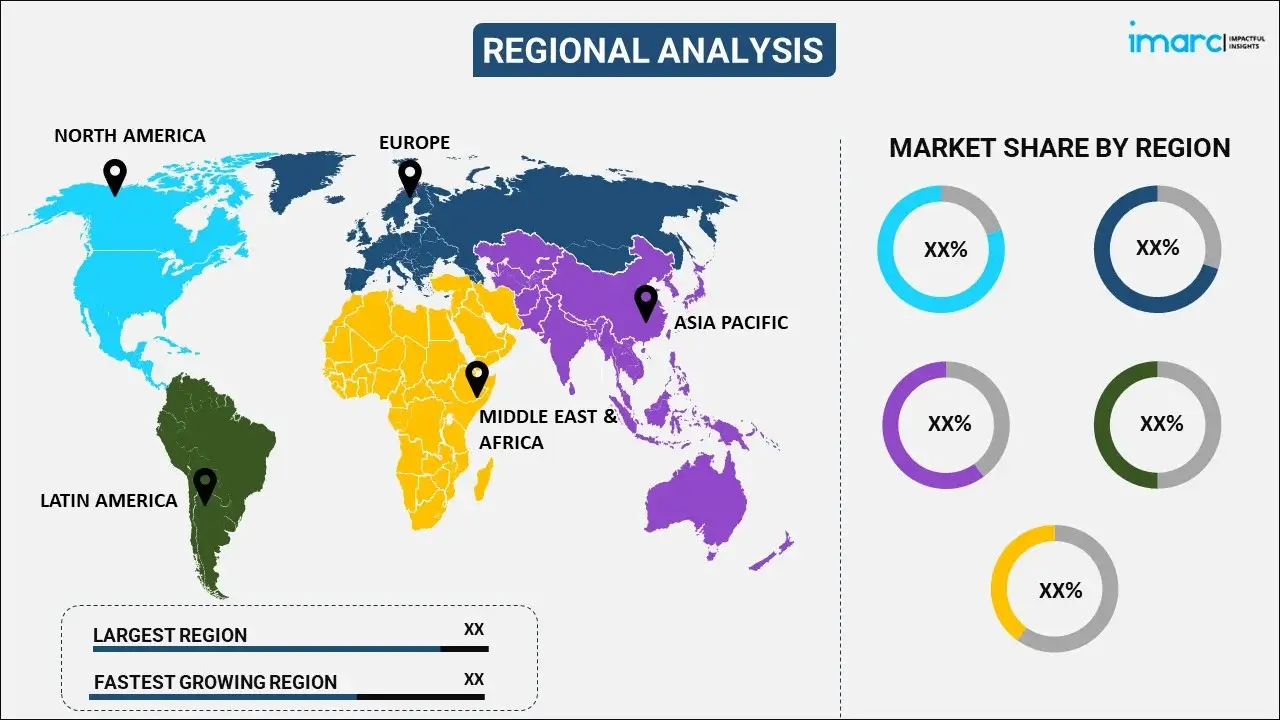
Malic Acid Market Report by Product (L-Malic Acid, D-Malic Acid, DL-Malic Acid), Application (Beverages, Confectionery and Food, Personal Care, and Others), and Region 2025-2033
Market Overview:
The global malic acid market size reached USD 232.0 Million in 2024. Looking forward, IMARC Group expects the market to reach USD 340.8 Million by 2033, exhibiting a growth rate (CAGR) of 4.02% during 2025-2033. The market is experiencing significant growth driven by the increased product adoption in the food and beverage industry for flavor enhancement, its rising application in cosmetics for skincare benefits, and its incorporation in health and fitness supplements for improved exercise performance.
|
Report Attribute
|
Key Statistics
|
|---|---|
|
Base Year
|
2024 |
|
Forecast Years
|
2025-2033 |
|
Historical Years
|
2019-2024
|
|
Market Size in 2024
|
USD 232.0 Million |
|
Market Forecast in 2033
|
USD 340.8 Million |
| Market Growth Rate 2025-2033 | 4.02% |
Malic acid, also known as hydroxybutanedioic acid, is a naturally occurring organic compound predominantly found in various fruits, most notably apples. It's best known for contributing to the sour or tart taste in fruits. Malic acid is employed extensively in the food and beverage industry as a flavor enhancer and preservative, being responsible for the tangy flavor in many candies, wines, and carbonated drinks. Besides its culinary applications, it also plays a pivotal role in skincare products due to its excellent exfoliating properties, which help in the removal of dead skin cells. Moreover, it is employed in the health and fitness industry due to its potential benefits in boosting exercise performance and reducing signs of aging.

One of the factors driving the market includes product adoption in the pharmaceutical industry. Malic acid is used in the pharmaceutical industry as an excipient, helping in the formulation of drugs. As the global healthcare sector continues to grow, the demand for malic acid in pharmaceuticals is expected to rise. In addition to this, malic acid is utilized in animal feed to enhance palatability and boost digestion. With the escalating demand for animal-based products, the requirement for high-quality animal feed is also increasing, which, in turn, is propelling the demand for malic acid in this sector. Furthermore, as consumers are becoming more health conscious, they are seeking natural and organic food additives. Malic acid, being a naturally occurring compound, is viewed as a healthier alternative to synthetic additives, driving its demand. In line with this, malic acid has been approved by major regulatory bodies such as the FDA and EFSA, which has boosted its adoption across various industries.
Malic Acid Market Trends/Drivers:
Rising Demand in Food and Beverage Industry
The continuous expansion in the global food and beverage industry is a significant driver for the market. Malic acid, with its ability to enhance flavor and serve as a preservative, is widely used in processed foods, candies, wines, and carbonated drinks. Moreover, the growing shift among food manufacturers toward natural ingredients is enhancing the product demand. The expanding global population, coupled with increasing disposable incomes, particularly in developing countries, has accelerated the consumption of these processed products. As consumers worldwide continue to demand diverse and innovative food flavors, the market is expected to witness stable growth.
Increasing Use in Cosmetics and Personal Care Products
On account of its excellent exfoliating properties, malic acid has emerged as a key ingredient in many skincare products, as it aids in dead skin cell removal, contributing to the youthful and healthy appearance of the skin. The flourishing cosmetic industry, fueled by changing consumer patterns and an increasing emphasis on self-care and beauty routines, is promoting the demand for quality ingredients like malic acid. The rise in online beauty platforms and influencer marketing is further amplifying the visibility of products containing malic acid, thereby boosting its market potential.
Expanding Applications in Health and Fitness Industry
The health benefits associated with malic acid have recently garnered attention, leading to its inclusion in health and dietary supplements. It is particularly noted for its potential to enhance exercise performance and reduce muscle fatigue, gaining traction among athletes and fitness enthusiasts. Additionally, there's an increased understanding of malic acid's potential role in relieving pain and improving energy levels in people suffering from fibromyalgia and chronic fatigue syndrome. The rise in health-conscious consumers seeking natural remedies and supplements to improve their fitness and overall well-being is creating a favorable environment for the growth of the market within the health and fitness industry.
Malic Acid Industry Segmentation:
IMARC Group provides an analysis of the key trends in each segment of the global malic acid market report, along with forecasts at the global and regional levels from 2025-2033. Our report has categorized the market based on product and application.
Breakup by Product:

- L-Malic Acid
- D-Malic Acid
- DL-Malic Acid
The report has provided a detailed breakup and analysis of the market based on the product. This includes L-malic acid, D-malic acid and DL-malic acid.
L-malic acid is the naturally occurring form of malic acid and is widely used across various industries. It is found in many fruits and is the form responsible for the sour taste in apples. It is widely employed in the food and beverage and pharmaceuticals industries. L-malic acid is also a preferred choice in the production of supplements due to its health benefits.
D-malic acid is a synthetic form and its usage is less common than L-malic acid. It's used in specific industrial processes and applications that require the unique properties of this synthetic isomer.
DL-malic acid, a mixture of D- and L-isomers, is also used in food and beverage industries as an acidulant and for flavor enhancement. Its lower cost compared to L-malic acid makes it an attractive choice in certain applications.
Breakup by Application:
- Beverages
- Confectionery and Food
- Personal Care
- Others
Beverages account for the majority of the market share
The report has provided a detailed breakup and analysis of the market based on the application. This includes beverages, confectionery and food, personal care, and others. According to the report, beverages represented the largest segment.
The global beverage market is experiencing rapid growth, driven by rising consumer incomes, urbanization, and a shift towards processed and convenience foods. The introduction of innovative beverage products, including health and wellness drinks, energy drinks, and non-alcoholic beverages, has further accelerated this growth. With the expansion of the beverage market, the demand for ingredients like malic acid naturally increases. Malic acid is primarily used in beverages as a flavor enhancer. It imparts a sour or tart taste, which is particularly desirable in carbonated drinks, fruit juices, and certain types of wine. This taste enhancement contributes to a refreshing and appealing flavor profile, which is popular among a broad range of consumers. It is also utilized as a preservative and pH regulator in beverages as it helps in extending the shelf-life of products and ensuring the quality and safety of drinks over time.
Breakup by Region:

- Asia Pacific
- North America
- Europe
- Middle East and Africa
- Latin America
Asia Pacific exhibits a clear dominance, accounting for the largest malic acid market share
The report has also provided a comprehensive analysis of all the major regional markets, which include Asia Pacific, North America, Middle East and Africa, Latin America, and Europe. According to the report, Asia Pacific represents the leading market. The region is home to some of the most populous countries in the world, including China and India. The rapid urbanization, coupled with a booming population, is creating a huge demand for processed food and beverages, which, in turn, is escalating the requirement for food additives like malic acid. In addition to this, the region has witnessed significant economic growth over the past years. The rising disposable incomes and changing lifestyle patterns are driving the demand for high-quality food and beverage products, as well as cosmetics and personal care products. Moreover, the growing awareness and focus on health and fitness in the region is boosting the consumption of dietary supplements and health-centric products.
Competitive Landscape:
Companies in the market are engaging in various strategies to expand their market share and stay competitive. They are investing heavily in research and development to find new applications for malic acid and improve the efficiency and sustainability of its production. This includes researching its potential uses in areas such as biodegradable plastics. Market players are also expanding their production capacities to meet the increasing global product demand. This involves upgrading their manufacturing infrastructure and adopting more advanced and efficient production technologies. Due to the increasing consumer demand for natural and organic products, companies are further focusing on developing new formulations for various applications, particularly in the food, beverage, and cosmetics industries.
The report has provided a comprehensive analysis of the competitive landscape in the market. Detailed profiles of all major companies have also been provided. Some of the key players in the market include:
- Bartek
- Changmao Biochemical Engineering Company Limited
- Fuso Chemical Co., Ltd.
- Polynt
- Thirumalai Chemicals
- Anhui Sealong Biotechnology
- Yongsan Chemicals
- Miles Chemical
- The Chemical Company
- Spectrum Chemical
- Isegen South Africa
- Corbion
- Mitsubishi Chemical
- Tate & Lyle
- Mubychem Group
Recent Developments:
- Bartek Ingredients has started construction on a new facility for malic and food-grade fumaric acid production, doubling the company's capacity. The US$160 Million project, expected to be completed in Q4 2023, will support Bartek's continued market expansion and enable the production of new products.
- TCL Specialties, a subsidiary of Thirumalai Chemicals Ltd., is beginning the construction of a chemical facility in the northeastern United States. The plant will produce maleic anhydride, malic acid, and fumaric acid with a capacity of 40,000 metric tons per year. It will serve customers in North America, Europe, and Latin America.
- Corbion is investing in its Spanish facilities to triple its production capacity for acid powder ingredients in response to the growing demand for sour gummy products in the confectionery market. The new production line, expected to be operational in the second half of 2025, will enable Corbion to meet the increasing demand for stable acid powders, which are essential for creating sour gummies.
Malic Acid Market Report Scope:
| Report Features | Details |
|---|---|
| Base Year of the Analysis | 2024 |
| Historical Period | 2019-2024 |
| Forecast Period | 2025-2033 |
| Units | Million USD |
| Scope of the Report | Exploration of Historical and Forecast Trends, Industry Catalysts and Challenges, Segment-Wise Historical and Predictive Market Assessment:
|
| Products Covered | L-Malic Acid, D-Malic Acid, DL-Malic Acid |
| Applications Covered | Beverages, Confectionery and Food, Personal Care, Others |
| Regions Covered | Asia Pacific, Europe, North America, Latin America, Middle East and Africa |
| Companies Covered | Changmao Biochem, Bartek, Thirumalai Chemicals, Fuso Chemical Co., Ltd, Polynt, Yongsan Chemicals, Anhui Sealong Biotechnology, The Chemical Company, Miles Chemical, Isegen South Africa, Spectrum Chemical, Mitsubishi Chemical, Corbion, Mubychem Group and Tate & Lyle |
| Customization Scope | 10% Free Customization |
| Post-Sale Analyst Support | 10-12 Weeks |
| Delivery Format | PDF and Excel through Email (We can also provide the editable version of the report in PPT/Word format on special request) |
Key Benefits for Stakeholders:
- IMARC’s report offers a comprehensive quantitative analysis of various market segments, historical and current market trends, market forecasts, and dynamics of the malic acid market from 2019-2033.
- The research study provides the latest information on the market drivers, challenges, and opportunities in the global malic acid market.
- The study maps the leading, as well as the fastest-growing, regional markets.
- Porter's five forces analysis assist stakeholders in assessing the impact of new entrants, competitive rivalry, supplier power, buyer power, and the threat of substitution. It helps stakeholders to analyze the level of competition within the malic acid industry and its attractiveness.
- Competitive landscape allows stakeholders to understand their competitive environment and provides an insight into the current positions of key players in the market.
Key Questions Answered in This Report
The global malic acid market was valued at USD 232.0 Million in 2024.
We expect the global malic acid market to exhibit a CAGR of 4.02% during 2025-2033.
The growing adoption of malic acid across the food processing industry for increasing the shelf life of the packaged food and bakery items is primarily driving the global malic acid market.
The sudden outbreak of the COVID-19 pandemic had led to the implementation of stringent lockdown regulations across several nations, resulting in the temporary halt in numerous production activities for malic acid.
Based on the application, the global malic acid market can be bifurcated into beverages, confectionery and food, personal care, and others. Currently, beverages exhibit a clear dominance in the market.
On a regional level, the market has been classified into Asia Pacific, North America, Europe, Middle East and Africa, and Latin America, where Asia Pacific currently dominates the global market.
Some of the major players in the global malic acid market include Changmao Biochem, Bartek, Thirumalai Chemicals, Fuso Chemical Co., Ltd, Polynt, Yongsan Chemicals, Anhui Sealong Biotechnology, The Chemical Company, Miles Chemical, Isegen South Africa, Spectrum Chemical, Mitsubishi Chemical, Corbion, Mubychem Group, and Tate & Lyle.
Need more help?
- Speak to our experienced analysts for insights on the current market scenarios.
- Include additional segments and countries to customize the report as per your requirement.
- Gain an unparalleled competitive advantage in your domain by understanding how to utilize the report and positively impacting your operations and revenue.
- For further assistance, please connect with our analysts.
 Inquire Before Buying
Inquire Before Buying
 Speak to an Analyst
Speak to an Analyst
 Request Brochure
Request Brochure
 Request Customization
Request Customization




.webp)




.webp)












